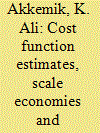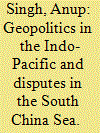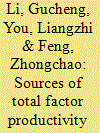|
|
|
Sort Order |
|
|
|
Items / Page
|
|
|
|
|
|
|
| Srl | Item |
| 1 |
ID:
088044


|
|
|
|
|
| Publication |
2009.
|
| Summary/Abstract |
Turkish electricity sector has undergone significant institutional changes since 1984. The recent developments since 2001 including the setting up of a regulatory agency to undertake the regulation of the sector and increasing participation of private investors in the field of electricity generation are of special interest. This paper estimates cost functions and investigates the degree of scale economies, overinvestment, and technological progress in the Turkish electricity generation sector for the period 1984-2006 using long-run and short-run translog cost functions. Estimations were done for six groups of firms, public and private. The results indicate existence of scale economies throughout the period of analysis, hence declining long-run average costs. The paper finds empirical support for the Averch-Johnson effect until 2001, i.e., firms overinvested in an environment where there are excess returns to capital. But this effect was reduced largely after 2002. Technological progress deteriorated slightly from 1984-1993 to 1994-2001 but improved after 2002. Overall, the paper found that regulation of the market under the newly established regulating agency after 2002 was effective and there are potential gains from such regulation.
|
|
|
|
|
|
|
|
|
|
|
|
|
|
|
|
| 2 |
ID:
125757


|
|
|
|
|
| Publication |
2013.
|
| Summary/Abstract |
Buildings are responsible for almost 40% of energy consumption and CO2 emissions in the EU (EC, 2010). Improving the energy efficiency of buildings is a vital step towards achieving the EU climate and energy objectives. Directive 2010/31/EU outlines measures specifically focused on the energy performance of buildings. Incentives are created for building operators to optimize their energy sub-systems in a more robust, energy-efficient, and cost-effective manner. The challenge is to choose efficient energy-supply portfolios accounting for technological and market deregulation and risks. Decision support tools for energy management in public buildings using future scenarios of market and technological developments would be beneficial. The aim of this paper is to discuss the drivers and uncertainties in the recent and future energy market trends and prices, including technological progress and developments in fossil-fuel markets. This discussion is relevant for researchers and policymakers in general, and in particular, as an input for scenarios used in the development of decision support systems.
|
|
|
|
|
|
|
|
|
|
|
|
|
|
|
|
| 3 |
ID:
138024


|
|
|
| 4 |
ID:
125543


|
|
|
|
|
| Publication |
2013.
|
| Summary/Abstract |
China faces growing environmental problems as rapid economic growth comes at the cost of excessive resource consumption. Sustainable development can only be realized by reducing energy intensity. Although some general factors that influence energy intensity have been described, less information is available to compare energy intensity in different regions. Here we use existing literature to assess the effects of three internal factors (economic structure, energy consumption structure, and technological progress) on energy intensity in three regions of China. We use panel data from 2000 to 2009 and find that the effects of each factor differ in each region. We further differentiate these effects by decomposing technological progress into three parts using the DEA-Malmquist approach. We find three components of technological change have completely different effects in each region. Furthermore, these findings are applied to propose relevant suggestions to reduce energy intensity in different regions of China.
|
|
|
|
|
|
|
|
|
|
|
|
|
|
|
|
| 5 |
ID:
177159


|
|
|
|
|
| Summary/Abstract |
This study evaluates grid parity in the Chinese solar PV industry by calculating the unsubsidized unit profits (UUPs) of solar PV projects in 335 Chinese cities. Furthermore, the effects of technological advances and various electricity price mechanisms on grid parity are explored. We consider the differences between centralized grid-connected and distributed projects. Two-factor learning curves are used to forecast technological progress and two kinds of electricity price mechanisms—government-regulated and market-based—are also brought into analyses. The results indicate the infeasibility of implementing complete grid parity regardless of the type of project. However, centralized grid-connected projects in 5 cities and distributed projects in 129 cities could implement pilot grid parity. On the whole, centralized grid-connected project has a lower benefit performance than distributed projects. Resource Zone I, which consists of Ningxia Province and several western cities in Gansu, Xinjiang and Inner Mongolia, has the best benefit performance of three resource areas. Technological advances and variations in electricity prices under both mechanisms could improve the UUPs but raising them above zero in all cities would still be impossible. The market prices of electricity under market-based mechanisms may generally have greater impacts than do government-regulated mechanisms on the benefit performances throughout the whole nation.
|
|
|
|
|
|
|
|
|
|
|
|
|
|
|
|
| 6 |
ID:
111146


|
|
|
| 7 |
ID:
177145


|
|
|
|
|
| Summary/Abstract |
Although energy technological progress has been regarded as an important driver for reducing carbon emissions, the existence of carbon rebound effect prevents a portion of the potential carbon reductions to be realized. Compared with the energy rebound effect, research on the carbon rebound effect is scarce because it is always equated with the energy rebound effect. However, the carbon rebound effect is more complex. Given that the traditional method for carbon rebound effect assessment only reflects energy rebound effects, our study proposed an improved production-theoretical decomposition analysis (PDA)-Meta-frontier Malmquist index (MMI)-based method and explored carbon rebound effects in China from 2006 to 2015. Our results show that (1) the eastern and western regions faced fewer carbon rebound effect risks compared with those of the central region due to decreasing emission intensity associated with energy technological progress; (2) the reductions in emission intensity in the eastern region relied both on coal and non-coal technology, whereas the western region only relied on coal technology; and (3) the non-coal technology in the eastern region was at the meta-frontier, whereas the non-coal technology of other regions exhibited catch-up effects.
|
|
|
|
|
|
|
|
|
|
|
|
|
|
|
|
| 8 |
ID:
159045


|
|
|
|
|
| Summary/Abstract |
We explain the dynamics of China's intra industry trade (IIT) development spanning over three decades from the perspective of institutional changes. We present two hypotheses after reviewing series of policy documents and related organizational adjustment descriptions. First, we argue that China's pro-liberal reform in trade and FDI institutions helped trade to take off. Second, China is ambitious in acquiring advanced technology and building up a sophisticated system to promote technological capability. An analysis of Grubel and Lloyd IIT index on intermediate goods trade belonging to SITC 7 and SITC 8- the key components of regional value chain in East Asia- suggests that the structural changes taking place in China's intermediate goods trade are in agreement with the stated hypotheses. China's institutional arrangements also help to explain the factor behind China's success in becoming a major player in the regional production network in East Asia.
|
|
|
|
|
|
|
|
|
|
|
|
|
|
|
|
| 9 |
ID:
088045


|
|
|
|
|
| Publication |
2009.
|
| Summary/Abstract |
As is known, the Kyoto protocol proposes to reinforce national policies for emission reduction and, furthermore, to cooperate with other contracting parties. In this context, it would be necessary to assess these emissions, both in general and specifically, by pollutants and/or among productive sectors. The objective of this paper is precisely to estimate the polluting emissions of industrial origin in Catalonia in the year 2001, in a multivariate context that explicitly allows a distinction to be made between the polluter and/or the productive sector causing this emission.
Six pollutants are considered, four directly related to greenhouse effect. A multi-level model, with two levels, pollutants and productive sectors, was specified. Both technological progress and elasticity of capital were introduced as random effects. Hence, it has been permitted that these coefficients vary according to one or the other level. The most important finding in this paper is that elasticity of capital has been estimated as very non-elastic, with a range that varies between 0.162 (the paper industry) and 0.556 (commerce). In fact, and generally speaking, greater the capital in the sector, lower the elasticity of capital estimated.
|
|
|
|
|
|
|
|
|
|
|
|
|
|
|
|
| 10 |
ID:
088947


|
|
|
|
|
| Publication |
2009.
|
| Summary/Abstract |
Energy issues receive more and more attention these days. And it is considered that technological progress is an essential approach to save energy. This essay is to analyze the relation between energy intensity and technological progress by Cobb-Douglas production function in which energy, labor, capital and technological progress are taken as independent variables. It proves that the growth of output per capital and output per labor will increase energy intensity while technological progress will decrease energy intensity. Empirical research on Chinese industry is used here to indicate technological progress greatly decreases energy intensity. Because of the interferences of Asian financial crisis, there is something abnormal in the data. So in the empirical research, average weaken buffer operator (ABWO) is applied to weaken the interference of Asian financial crisis to the fixed assets, energy and value added. The results of the empirical research show that technological progress decreases energy intensity of Chinese industry an average of 6.3% every year in China.
|
|
|
|
|
|
|
|
|
|
|
|
|
|
|
|
| 11 |
ID:
105280


|
|
|
|
|
| Publication |
2011.
|
| Summary/Abstract |
Provincial panel data from the agricultural sector and stochastic frontier production function model were employed to study the total factor productivity (TFP) growth since the 1980s in China. We decomposed the TFP growth into technological progress and technical efficiency changes (efficiency gains) as well as the aggregate agricultural TFP growth into crop-specific subsector's TFP growths. We found that Chinese agriculture experienced significant productivity growth in the last few decades, although the growth rates vary considerably among the subsectors. During this period, the source of productivity growth comes from either technological progress or efficiency gains, not from both of them simultaneously. Particularly since the 1990s, Chinese agriculture experienced a great technological progress and yet a considerable efficiency loss. The differences among sources of productivity growth and among subsectors call for distinct policy responses.
|
|
|
|
|
|
|
|
|
|
|
|
|
|
|
|
| 12 |
ID:
067282


|
|
|
| 13 |
ID:
179666


|
|
|
|
|
| Summary/Abstract |
Technological progress is an effective way to improve fuel economy in vehicles. Using a rich model-level dataset of all new passenger cars in China from 2010 to 2019, this paper estimates progress in fuel economy after controlling for increases in vehicle performance. Considering the unique structure of the automobile industry in China, we explore differences between indigenous vehicles (IV), joint venture vehicles (JV), and foreign vehicles (FV). The results show that a 10% increase in curb weight is correlated with a 6.4% increase in fuel consumption. When holding other vehicle characteristics constant, technological progress can reduce fuel consumption by 3.5% annually. Technological progress is larger for JV (3.9%) than FV (3.3%) and IV (3.1%). In particular, IV produced by firms that are also engaged in JV showed slower technological progress (2.6%) than other IV counterparts (3.9%). A majority of JV would be able to meet future fuel consumption standards on individual vehicles at the average historical rate of technological progress. In contrast, IV will face a greater challenge, especially for IV produced by firms with JV. Although weight reduction can reduce fuel consumption, it plays a limited role in regulatory compliance due to the weight-based regulations.
|
|
|
|
|
|
|
|
|
|
|
|
|
|
|
|
| 14 |
ID:
132615


|
|
|
|
|
| Publication |
2014.
|
| Summary/Abstract |
The energy rebound effect has been a significant issue in China, which is undergoing economic transition, since it reflects the effectiveness of energy-saving policy relying on improved energy efficiency. Based on the IPAT equation and Brookes× explanation of the rebound effect, this paper develops an alternative estimation model of the rebound effect. By using the estimation model and latent variable approach, which is achieved through a time-varying coefficient state space model, we estimate China×s economy-wide energy rebound effect over 1954-2010. The results show that the rebound effect evidently exists in China as a result of the annual average of 39.73% over 1954-2010. Before and after the implementation of China×s reform and opening-up policy in 1978, the rebound effects are 47.24% and 37.32%, with a strong fluctuation and a circuitously downward trend, respectively, indicating that a stable political environment and the development of market economy system facilitate the effectiveness of energy-saving policy. Although the energy-saving effect of improving energy efficiency has been partly realised, there remains a large energy-saving potential in China.
|
|
|
|
|
|
|
|
|
|
|
|
|
|
|
|
| 15 |
ID:
180140


|
|
|
|
|
| Summary/Abstract |
How do we design clean energy subsidies to deliver greater benefits to society? Analytical answers to this question are scarce. Modeling should address both direct benefits from stimulating consumer adoption the year the subsidy is paid as well as indirect benefits from lowering future technology costs. We develop a benefit-cost analysis of residential solar subsidies in the US, disaggregated by state, accounting for technological progress, consumer adoption, and carbon and criteria emission reductions. We assess existing solar subsidies and also find the optimal subsidy schedule that maximizes net benefits starting in the year 2018. In the base case the national flexible optimal subsidy schedule begins at $585/kW and declines to zero in 14 years. The optimal subsidy starts higher and falls more quickly than the current federal tax credit, due to long-term benefits from early cost reductions and the need to reduce subsidies as a technology becomes cheaper. We also estimate state-by-state flexible subsidies which result in higher net benefits compared to a homogenous national subsidy ($2.8 billion versus $1.0 billion). Neglecting criteria pollution benefits, optimal subsidies accounting for technological progress and consumer behavior cost the government $45–49 per ton of carbon abated, much lower than the total abatement cost.
|
|
|
|
|
|
|
|
|
|
|
|
|
|
|
|
| 16 |
ID:
139337


|
|
|
|
|
| Summary/Abstract |
The debate over what technology does to work, jobs, and wages is as old as the industrial era itself. In the second decade of the nineteenth century, a group of English textile workers called the Luddites protested the introduction of spinning frames and power looms, machines of the nascent Industrial Revolution that threatened to leave them without jobs. Since then, each new burst of technological progress has brought with it another wave of concern about a possible mass displacement of labor.
|
|
|
|
|
|
|
|
|
|
|
|
|
|
|
|
|
|
|
|
|